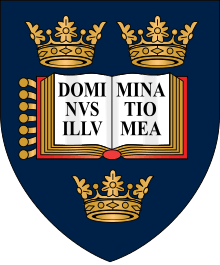Merton College Chapel
| Merton College Chapel, Oxford | |
|---|---|
 Merton College Chapel viewed from Grove Walk. | |
| Location | Merton College, Oxford, England |
| Country | United Kingdom |
| Denomination | Church of England |
| Website | Official website |
| History | |
| Founder(s) | Walter de Merton |
| Architecture | |
| Style | Gothic |
| Groundbreaking | c1290 |
| Completed |
1294 (choir) transepts (1424–5) tower 1448–51 |
| Administration | |
| Diocese | Oxford |
| Clergy | |
| Chaplain(s) | Rev. Dr. Simon Jones |
| Laity | |
| Director of music | Benjamin Nicholas & Peter Phillips |
Merton College Chapel is the church of Merton College, Oxford, England. Dedicated to St Mary and St John the Baptist, the chapel was largely completed in its present form the end of the 13th century.
History
On 13 September 1266 the church of St John the Baptist was granted to the scholars of Merton College by the Abbey of Reading.[1] However, by the late 1280s it had fallen into "a ruinous condition",[2] and Merton college accounts show that work on a new church on the same site began in about 1290.
The present choir with its enormous east window was complete by 1294. The window is an important example (because it is so well dated) of how the strict geometrical conventions of the Early English Period of architecture were beginning to be relaxed at the end of the 13th century.[3] The south transept was built in the 14th century, the north transept in the early years of the 15th century. The great tower was complete by 1450. The chapel replaced the parish church of St. John and continued to serve as the parish church as well as the chapel until 1891. It is for this reason that it is generally referred to as Merton Church in older documents, and that there is a north door into the street as well as doors into the college. This dual role also probably explains the enormous scale of the chapel, which in its original design was to have a nave and two aisles extending to the west.[4]
In the early 16th century, the college appears to have abandoned plans to extend the chapel, as the land on which the nave would have been built was leased in 1517 to Richard Foxe (c1448–1528), Bishop of Winchester, founder of Corpus Christi College, next door to Merton.[5]
Reformation
The Reformation did not leave Merton Chapel untouched. During the reign of the zealously Protestant Edward VI (1547–1553), traditional forms of worship began to change, and it was most likely at this time that the medieval stained glass was removed. However, Edward died young, and during the reign of his sister Mary I (1553–1558) Catholicism was restored, enthusiastically embraced by the college. Soon afterwards, under Elizabeth I, Protestantism was once again enforced and Merton college found itself facing a siege against Elizabeth's Archbishop of Canterbury, Matthew Parker for three weeks, in defence of the old religion.[6]
Restoration projects
The church was in a bad physical state by the seventeenth century, leading to a number of rebuilding projects by architects including Christopher Wren and Edward Blore.
Modern era

A new choral foundation was established in 2008 when Peter Phillips and Benjamin Nicholas were appointed Directors of Music. The choir consists of twenty-eight singers, of whom eighteen are choral scholars; there are also two organ scholars. The choir has toured in France (2009 and 2010), the USA (2011) and in Sweden (2013) and features prominently during Merton's annual festival Passiontide at Merton. The choir's repertoire includes a number of pieces written for the College Choir by Howard Skempton, Gabriel Jackson and John Tavener. The college celebrates its 750th anniversary in 2014, when the Merton Choirbook will be premiered.
The College also recently commissioned a new organ to be installed, to coincide with the anniversary celebrations. The organ was built by Dobson Pipe Organ Builders from Lake City, Iowa and arrived in August 2013. It will be officially opened at the Organ Festival weekend in April 2014.
A spire from the chapel has resided in Pavilion Garden VI of the University of Virginia since 1928, when "it was given to the University to honor Jefferson's educational ideals".[7]
Gallery
 Merton College from Christ Church Meadow
Merton College from Christ Church Meadow- Merton College (including chapel) viewed from the north from St Mary's Church
 The interior of the chapel from under the tower, looking towards the roof, with the former organ on the left
The interior of the chapel from under the tower, looking towards the roof, with the former organ on the left
See also
- Merton College Library
- Mob Quad at Merton
References
- ↑ Henderson, Bernard William, p.26, Merton College, (1899). Retrieved 9 February 2010
- ↑ Anthony Wood, quoted in Bott, p.24
- ↑ Pevsner, p.25
- ↑ See Bott, pp.24–37
- ↑ History of Merton Chapel. Retrieved 9 February 2010.
- ↑ History of Merton Chapel. Retrieved 9 February 2010.
- ↑ "Explore the Gardens, Pavilion Garden VI". University of Virginia. 11 June 2009. Retrieved 11 June 2009.
Bibliography
- Henderson, Bernard William, Merton College, (1899). Retrieved 9 February 2010
- Highfield, J. R. L., and Martin, G. H., A History of Merton College, Oxford. Oxford (1997).
- Parker, John Henry, An Introduction to the Study of Gothic Architecture. London; Parker and Co. (1891) Retrieved 9 February 2010
External links
| Wikimedia Commons has media related to Merton College, Oxford. |
